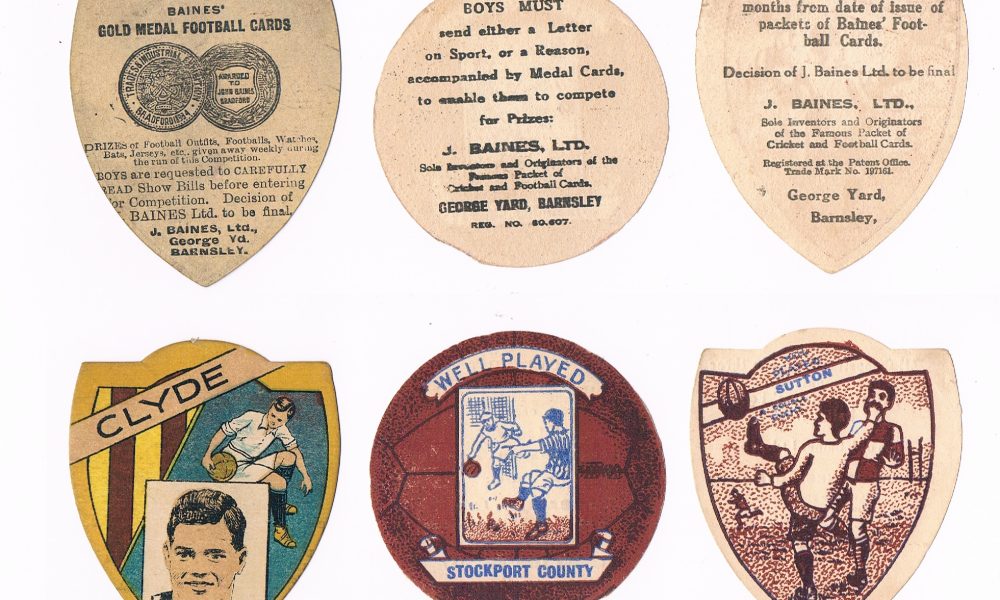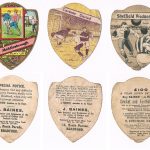If you haven’t checked out part 1 of our series on Baines, make sure you read that.
Emerging from the shadows of history, the first sports cards by Baines were simple. They had one or two-color designs and plain backs. Most featured a team’s name, a rugby ball, or a simple graphic such as a cup. Sportsmen did not appear on these cards. That trend began in 1883.
“Baines Cigar Emporium” was a common stamp on these cards. This was a mark of Baines. Most stamps were oval-shaped, but there were also intricate ones.
Richardson, a printer from Leeds, likely made these cards. Baines, based in Manningham, acted as the publisher. Alf Cooke, another Leeds printer, also made cards. Baines used these to promote his “Lucky Bags”. Over time, Baines made these generic cards his own.
Baines also adapted cards from competitors like Briggs. Briggs was another sports card publisher from Leeds. Cards from this era often carried Baines’ rubber stamps. They also had the original issuer’s name and the printer’s name. The printer’s mark was usually small and placed around the card’s frame. The names of the publisher, merchant, or advertiser were on the back of the card.
Below are some of the earliest Baines cards. They had plain backs and simple designs. A Baines rubber stamp marked these cards. They date back to the early 1880s, a significant era in sports card history.
Timeline: 1882 and Earlier
Before 1882, sportsmen didn’t grace the cards. Instead, they showcased symbolic imagery, complete with a rubber stamp on the back

Timeline: 1883 – 1886

Timeline: 1886
1886 marked a milestone in sports card history. The year saw the debut of the first soccer card, featuring Arthur Wharton. Before mid-1886, the cards displayed the address 68 Carlisle Road. But from mid-1886 to 1888, a new address, 72 Carlisle Road, replaced the old one, hinting at a change in the business location.

Timeline: 1890s – It’s All Gone Rectangular
The year 1890 brought a shift in the design of Baines’ cards. This time, the cards took on a rectangular shape. These cards boasted a golden border and portrayed four international rugby players. Some even featured the Queen. The cards bore two addresses: 65 & 72 Carlisle Road. This double-address mark dates back to the time of Baines’ horse-drawn carriage, which also displayed these addresses.
At first, some speculated these cards were from 1887. This was a year of grand celebrations for Queen Victoria’s Golden Jubilee, marking her half-century reign. However, the cards were actually from 1890. They were issued to celebrate England’s return to the Home Nations tournament that year. The appearance of players like Piercy Henderson Morrison and Jim Valentine, who played their first caps in 1890, confirms this.
The Scotland card from the same series displayed Bill MacLagan, Don Wauchope, Charles Reid, and T.W. Irvine. Although they didn’t play in 1890, they had been regular choices for Scotland in prior years. The inclusion of Valentine and Morrison on the England card conclusively dates it to 1890 or later.
We know that the 72 Carlisle Road address appeared on cards as early as 1886. Seeing this address on the 1890 cards indicates that the dual address of 65 & 72 Carlisle Road might have been used as late as 1891. It was on these large rugby rectangles that Baines claimed the title of ‘Football Card King’.
Baines also produced advertising cards throughout the 1880s. These cards, which bore the maker’s mark ‘Baines Litho, Manningham,’ promoted various products. From large shield-shaped cards to smaller heart and fan-shaped cards, these advertised popular products such as Pears Soap and Halstead’s Ointment.




As we transition into the dawn of the 20th century, we encounter cards issued around 1898. These carry the Gold Medal emblem, but interestingly, they lack the patent number and don’t carry the ‘Ltd’ signifier. This marks a new era in Baines cards, reflecting the changing times.

Timeline: 1909-1925 – Transition and Transformation: The Post-Victorian Era
John Baines Sr. died in December 1908, but the card production didn’t stop. Businesses in the Baines family kept making large shield cards, which were common in the late Victorian and Edwardian periods.
Starting from 1909, they continued this tradition until World War One. That’s when they started making changes to their designs. They began creating cards that were shaped like narrower shields and balls, showing different sports like cricket, golf, rugby, and soccer.




Cards bearing the 48 Nelson Road, Gillingham, Kent address represent the last known creations of J.Baines. This should not be confused with J.Baines Ltd, which had moved to Barnsley by this time. While these cards are some of the rarest, they are not the most visually appealing in the Baines collection.

Timeline: 1926 – The End of an Era
The Baines family ceased producing cards in 1926. This marked the end of a 45-year period of unique, shaped sports cards. These cards were the first of their kind, kick-starting the era of sports card collecting.
In response to this closure, Boys’ Magazine honored Baines in 1926. They created their own shield-shaped cards, paying tribute to the original designs.
This gesture of respect continued into the late 1920s and early 1930s. Other companies began producing similar shield-shaped cards. Each was a nod to Baines, the pioneers of sports card production.



No Comment! Be the first one.